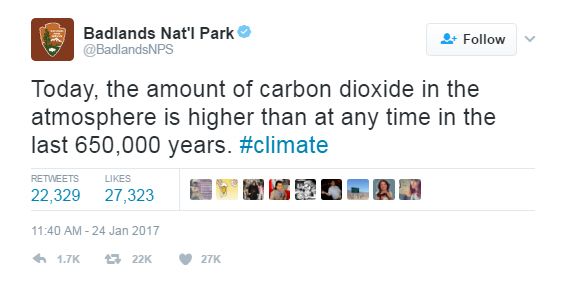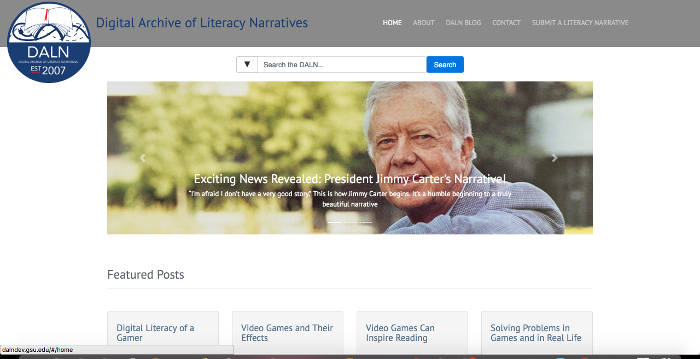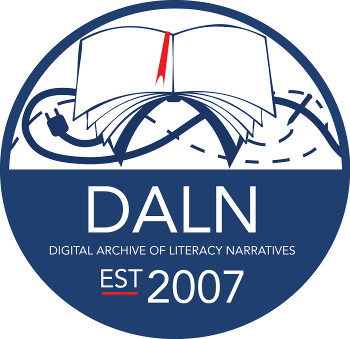Composition Forum 36, Summer 2017
http://compositionforum.com/issue/36/
Some Thoughts on the DALN as Public Utility

Figure 1. Badlands National Park Tweet. 24 Jan, 2017
It started with a tweet. In response to the incoming Trump administration’s science-resistant position to the issue of climate change, the official Twitter account for the Badlands National Park began to push back, sharing with its followers facts about, for example, the human impact on the planet’s CO2 levels. And even though pressure from the NPS administration, and perhaps from the White House itself, led the official account to remove the rogue tweets, the toothpaste was out of the tube; unofficial copycat accounts (@BadlandsNPSFans, @BadHombreNPS) began to spring up in solidarity to the Badlands account, picking up where it left off to continue promoting a science-friendly activist agenda (Davis).
Pundits and some scholars have been quick to highlight the actions taken by some National Park Service (NPS) representatives. Focus seems to be on the “rogue” nature of certain NPS representatives or the lack of control the executive branch possesses when it comes to message management throughout government. Others have highlighted this incident to advance ostensibly opposing agendas. What all of these responses have in common is the implication that the National Park Service was somehow detached from conversations about free speech (and other inalienable rights) in the first place. The truth is that from the beginning—and by design—the NPS has always functioned very much like a public utility for activism. Charged with the task of preserving “unimpaired the natural and cultural resources and values of the National Park System for the enjoyment, education, and inspiration of this and future generations,” the NPS’s mission situates the agency squarely where public and private interests intersect with advocacy.
Given the entangled nature of these pressures, it’s no surprise, then, that the entire operation requires enormous investment, especially when it comes to people. “More than 20,000 strong,” the NPS writes, “the uncommon men and women of the National Park Service share a common trait: a passion for caring for the nation's special places and sharing their stories” (National Parks Service). As we’re learning, when some limits are exceeded, the seemingly benign aims of preserving and sharing stories has the potential to activate dissent, mobilize supporters, challenge the status quo, and function as a public utility for advocacy in meaningful and persistent ways.
Although the Digital Archive of Literacy Narratives (DALN) cannot yet count as many volunteers among its ranks, at 7,000 literacy narratives and counting, it’s becoming clear to us that the archive’s joint commitment to preserving and sharing stories make it a valuable and important resource to our profession and the public. And while the DALN’s mission remains to “provide a historical record of the literacy practices and values of contributors, as those practices and values change” (Digital Archive of Literacy Narratives) shifts in our political climate and changes in attitudes about the relationships of technology to literacy, learning, and schooling invite us rethink and reenvision the form and function of the DALN.
The Power of Metaphor: Reconceptualizing, Rebranding, Rebuilding, Reseeing
As anyone familiar with the archive knows, the DALN showcases literacy narratives of all shapes and sizes, making it the largest, publicly accessible, digital archive devoted to literacy. Just as remarkable, however, is the frequency with which narratives appear in the submission queue. As co-directors of the DALN, we’re responsible for managing the day-to-day operations of the archive. An important part of these duties includes managing submissions to the DALN. Every time a user uploads a literacy narrative, we receive notifications in our inboxes asking us to review and approve the submission for archiving in the database.
This operational view of the project, which we wish we could share with more people, reveals, in a sense, the energy powering the engine of the DALN. With every new and approved narrative, we gain insight into the pace and reasons for the DALN’s growth. We also witness, in real time, how the thematic commitments of submissions sometimes parallel events in the news, trends in education, cultural developments, and economic dislocations. This isn’t surprising since the DALN, like other digital archiving projects as well as oral history collections of generations’ past, aims to preserve contributors’ views and values in a particular moment in time. But what makes the DALN unique is the way it reflects back to the world how our current technological moment requires—with increasing urgency—digitally mediated expertise as well as aptitudes for gaining “new” literacies and a willingness to let go of more traditional understandings of literate practice.
Daniel Keller and others characterize this era as “the age of acceleration,” one in which the wisdom required to engage mindfully with literacy and technology may be outpaced by the demands placed on our time. According to Keller, however, “Although literacy is constantly accumulating and accelerating, demanding more and more from literacy learners and teachers, we are not powerless in the face of such demands” (169). On the contrary, we believe resources like the DALN can function as a sort of public utility of literacy for teacher-researchers, offering rich stories of advocacy for learning and, thus, the evidence and power to challenge restricted views of what is possible for teachers and students inside and outside of the classroom. Rethinking the DALN as a public utility also highlights how, in providing this power, the DALN provides user-contributors with “some measure of control over how literacy influences them and how they influence literacy” (169).

Figure 2. Screenshot depicting updated design of DALN, currently in development
As we began rethinking the DALN brand with the sensibilities of public utilities in mind, we were mindful of how best to meet the needs of current users but also hoped to increase the archive’s appeal by making it more accessible. This shows not only in terms of the ongoing visual redesign of the site but also in terms of how we’ve changed elements related to functionality and overall user experience.
On the technical side of things, this has meant making significant changes to how we deliver content to user-contributors. Working with a team of developers from Georgia State University (Brennan Collins, Shakib Ahmed, Wasfi Momen, Jaro Klc, and Lisa Kitto), we decided to update our database management software by incorporating streaming services (e.g., Soundcloud, Sprout Video), providing users with more immediate access to the archival contents. The site design is also optimized to work across various platforms, including mobile devices such as smartphones and tablets, adding to the site’s overall accessibility and modernizing the look in the process. With respect to design, Erin Bahl (PhD Candidate, The Ohio State University) stepped up and brought the public utility/national park vibe to the DALN with a redesigned logo.

Figure 3. DALN logo redesign by Erin Bahl
Relying on a minimalist design philosophy—and inspired by the National Park Association’s design guidelines—the redesigned archive puts literacy narratives front and center with stories from contributors appearing on the landing page. In keeping with our commitment to making the DALN more like a public utility—and as useful as possible—we have also streamlined the upload, search, and push to social media functions of the site.
Productive Disruptions: Voices From the Archive
The value of any public utility is in the citizens it serves. Delivering clean drinking water or electricity to a population is only useful insofar as it allows those citizens to thrive, to contribute to the higher-order needs of a society: the advancement of humanistic and scientific knowledge, its artistic and cultural expression, its civic engagement. In this respect, the DALN contributes in no small way to providing a platform, a mouthpiece for anyone to speak back to the larger, more powerful institutional forces that shape our contemporary views about literacy and learning more broadly. But rather than simply speak on behalf of the voices included in the DALN, we thought we'd instead conclude this piece by directing our readers to entries in the archive that actually do the work of critical intervention. Here's a collection of submissions that touch on themes of disruption, the unexpected, and activism—that productively challenge disciplinary, public, or commonsensical attitudes about literacy and its effects. Below are a few short descriptions of some of those voices that can be found in the DALN:
Danielle Slaughter, How Parenting Helped Me Find My Voice
http://hdl.handle.net/2374.DALN/6636
In this video narrative, Danielle describes using literacy as a means of critical intervention for school and community shootings (specifically, she mentions Newtown and Michael Brown). In it, she recounts how public-facing rhetoric and literacy (i.e., blogging) led to a viral narrative about something timely and important to Danielle’s identity, which led her to more explicitly identify and address instances of implicit bias in her own life and culture at large.
Horace Newsum/H.Ike Okafor-Newsum, Born in a Moment of Urgency
http://hdl.handle.net/2374.DALN/6352
Here, Newsum describes his experiences directing the OSU Department of African-American and African Studies Community Extension Center, which works closely with historically black Columbus-area neighborhoods for purposes of cultural and historical preservation. Here, the DALN is documenting in a different way (than local publications and news stories in Columbus) an important effort to remember a community for its contributions. Lessons from this narrative may defy disciplinary conventions or expectations about literacy because of the way it reveals the varied and uneven relationship literacy sometimes shares with activist rhetorics.
Jennie Sheinbach, An Anti-Capitalist Cupcake Narrative
http://hdl.handle.net/2374.DALN/3239
We think this contribution from 2012 was a little ahead of the cultural zeitgeist: “A real unveiling of the truth is what we need,” Sheinbach states, “we need to be fully literate at this time.” In An Anti-Capitalist Cupcake Narrative, a business owner from the midwest discusses how her understanding of literacy intersects with her views on co-ops, sustainability, veganism, community, and the importance of the truth.
Saido Mohamed, My Voice is My Power
http://hdl.handle.net/2374.DALN/6292
In My Voice is My Power, Saido Mohamed discusses the importance of literacy and the humanities, noting that literacy acquisition often brings with it a particular kind of power—to speak when one isn’t physically present to do so. This narrative also touches on the importance of community, similarities and differences between oral and written literacies, and the difficulties that arise from possessing two types of literacy simultaneously.
Of course, these are only a select few of many narratives within the DALN that help demonstrate the cumulative power of the archive to contribute in real ways to our culture’s thoughts and beliefs about literacy practices. Over time, and as the collection grows, that power will only increase, and what might otherwise be construed as isolated accounts of rogue voices will make up a chorus of critically valuable perspectives that will help shape our conversations about literacy practices, policies, and values moving forward.
Works Cited
@BadlandsNPS. Today, the amount of carbon dioxide in the atmosphere is higher than at any time in the last 650,000 years - #climate. Twitter, 24 Jan. 2017, 11:40 a.m. https://twitter.com/BadlandsNPS_USA/status/824047102338600960.
Barton, David. Literacy: An Introduction to the Ecology of Literacy. Blackwell Publishing, 2007.
Davis, Wynne. Rogue National Park Accounts Emerge On Twitter Amid Social Media Gag Orders. National Public Radio, 25 Jan. 2017, http://www.npr.org/sections/alltechconsidered/2017/01/25/511664825/rogue-national-park-accounts-emerge-on-twitter-amid-social-media-gag-orders. Accessed 10 Feb. 2017.
Digital Archive of Literacy Narratives. DALN Home. Digital Archive of Literacy Narratives. http://daln.osu.edu. Accessed 14 July 2017.
Keller, Daniel. Chasing Literacy: Reading and Writing in the Age of Acceleration. Utah State University Press, 2014.
Mohamed, Saido. My Voice is My Power. Digital Archive of Literacy Narratives. 3 Dec. 2015. http://daln.osu.edu/handle/2374.DALN/6292. Accessed 14 June 2017.
National Parks Service. About Us. National Parks Service. 9 Feb. 2017. https://www.nps.gov/aboutus/index.htm. Accessed 14th July 2017.
Newsum, Horace/H.Ike Okafor-Newsum. Born in a Moment of Urgency. Digital Archive of Literacy Narratives. 10 May 2015, http://daln.osu.edu/handle/2374.DALN/6352. Accessed 14th June, 2017.
Sheinbach, Jennie. An Anti-Capitalist Cupcake Narrative. Digital Archive of Literacy Narratives. 7 Oct. 2012. http://daln.osu.edu/handle/2374.DALN/3239. Accessed 14 June, 2017.
Slaughter, Danielle. How Parenting Helped Me Find My Voice. Digital Archive of Literacy Narratives. 7 April 2016, http://daln.osu.edu/handle/2374.DALN/6636. Accessed 14th June 2017.
DALN as Public Utility from Composition Forum 36 (Summer 2017)
Online at: http://compositionforum.com/issue/36/public-utility.php
© Copyright 2017 Michael Harker and Ben McCorkle.
Licensed under a Creative Commons Attribution-Share Alike License.
Return to Composition Forum 36 table of contents.
